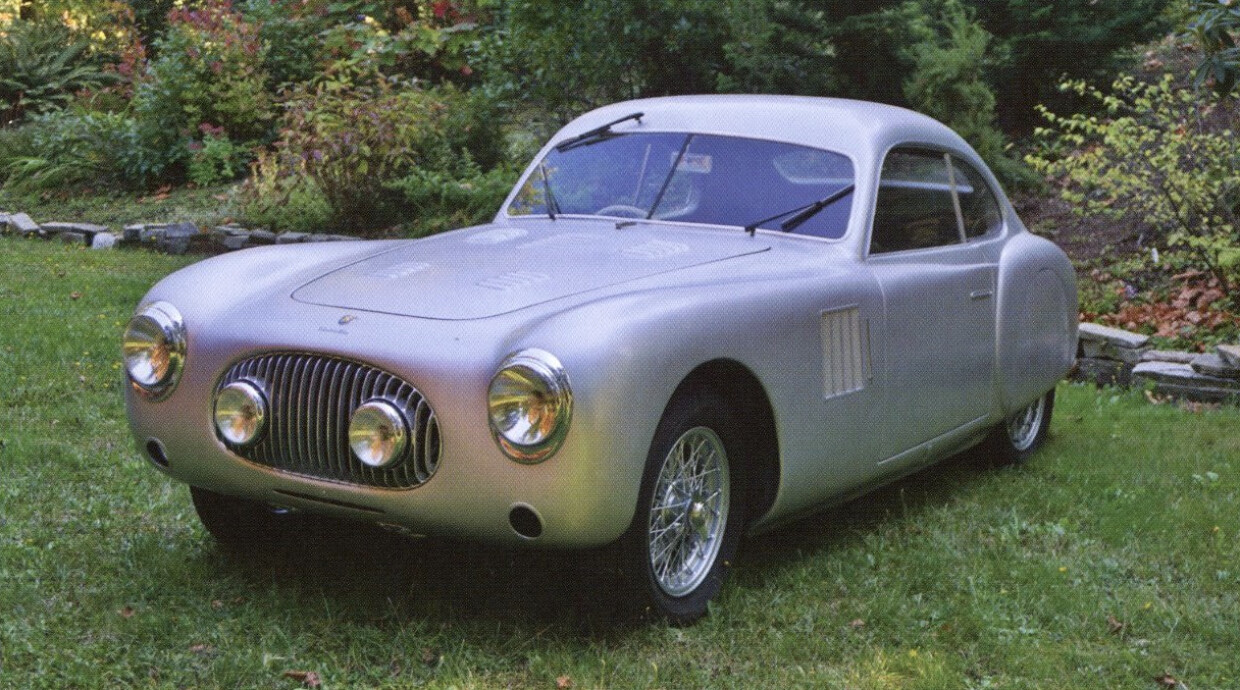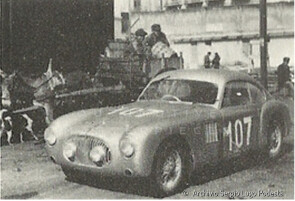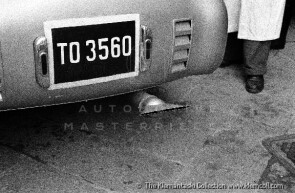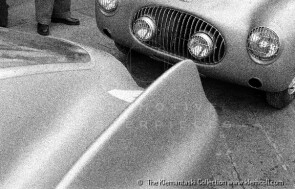
1948 Cisitalia 202 Corsa
ON/OFF
Why am I an Automotive Masterpiece?
H. Works cars
Cisitalia Automobili (I)
L. Limited edition cars
no. 3 manufactured
Founded in 1939 by Turinese texile industrialist Piero Dusio to manufacture sports equipment, Consorzio Industriale Sportiva Italia (Cisitalia) amassed a fortune for its former soccer star owner making military uniforms during WW2. An experienced amateur driver, Dusio used his fortune to become involved with the sport he loved. After winning his class on the 1937 Mille Miglia, he began to explore the possibilities of building his own racing cars. Cisitalia's first model was the D46 appeared in 1946, a small single seater which used a tubular steel space-frame chassis crafted at Cisitalia’s bicycle factory to support readily-available Fiat mechanicals as Fiat 1090cc engine and Fiat 500 suspension. After fifty D46s were sold and the model archived a debut victory in the Coppa Brezzi in Turin, Cisitalia focused on building small passenger car based on the D46, including it's Fiat components and space frame chassis. In the summer of 1946, the 202 CMM (Coupé Mille Miglia) was initially designed by Dante Giacosa and continued by Giovanni Savonuzzi (hired by Dusio in August 1945). The first coupé was built by Alfredo Vignale, at the time the departmental head of Stabilimenti Farina and allowed him to set up his own carrozzeria. The Cisitalia 202 SMM (Spyder Mille Miglia) was derived directly from the coupé. After Nuvolari epic effort, subsequent competition spiders were known as 202 SMM Nuvolaris. Savonuzzi’s design, was submitted to Battista Pinin Farina as an initial concept for the new coupé 202 Gran Sport and inspired the master to create one of the most significant example of body styling in automotive history. Cisitalia provided Pinin Farina with the chassis on which the Cisitalia's body was placed. The body was more or less handcrafted, with its aluminum panels shaped over wooden forms. Its shapes are the finishing point of all the previous research: the hood, body, fenders, and headlights are integral to the continuously flowing surface, rather than added on, creating a general sense of beaty and speed. Unveiled in 1947 at the exhibition of Coachbuilders at the Milan Triennale and Paris Motor Show, it won the Coppa d’Oro prize at the Villa d’Este Concours d’Elegance. The Cisitalia 202 Gran Sport was defined as “a rolling sculpture” in 1951 when it was chosen, along with seven other cars, for an exhibition at the Museum of Modern Art in New York (MoMA). The 202 is the progenitor of all modern sports cars stands as a timeless bridge between pre- and post-war sports car design. Its lines had a strong impact on the aesthetics of car design at the time, breaking with tradition and introducing new concepts in style. Coupé versions of the 202 were the first produced. A cabriolet followed. The 202 were built around low-cost Fiat components including a redesigning chassis and a 1089cc four-cylinder engine delivering 66 horsepower. The first Gran Sport model has only two seats and is the first car in history to have the brand name even in the back. The first development, the 202 Berlinetta - or B - can instead accommodate four people (three in front and one, bad, behind) and is distinguished by its more massive grille and chrome bumpers. The 1951 202 C has the the trunk accessible from outside and the rear window wider. The early 202 grill was aluminum and had 23 individual teeth shaped like a "D" with the curved part facing forward, and a narrow surround. The later 202 had a chrome plated grill with 18 thicker teeth and a thicker surround. The twin windscreen was later replaced with a one piece curved windscreen. The 202 body production by Pinin Farina soon shifted over to Stabilimenti Farina and, to a lesser extent, Vignale. Both built the 202 to Battista Pinin Farina's original design, although there are some differences. It was expensive, and only 170 were produced between 1947 and 1952, 153 coupes and 17 cabriolet.
Cisitalia chassis no. 066 is one of three special “Corsa” coupes prepared for the Mille Miglia and Targa Florio races in 1948. Dante Giacosa, who helped Piero Dusio start Cisitalia, states in his autobiography “I miei 40 anni di progettazione alla Fiat” that these cars were the prototypes of the later 202 coupe, and built by Stabilimenti Farina. These early cars have a chassis tag that reads “TIPO D46 SPORT,” being an evolution of the D46 “monoposto” racing cars to “biposto” configuration. After production increased, the tags were changed to “TIPO 202” on the later coupes. It is theorized that about 65 chassis numbers were pre-allocated for production cars, primarily by Pinin Farina, so the next available chassis numbers, 066 and 067, were used as “Squadra Piero Dusio” factory team cars for the 1948 race season. Cisitalia chassis no. 066 (together with its “sisters” Corsa coupes) is different from the later production cars in many ways, for example the inverted arch tube in the lower door sills was not yet present, which was added on later cars for extra strength. Many weight saving measures were applied, and official factory documents report a weight of only 727 kg without fuel. There are no coachbuilder body panel stampings on 066, but as noted above, Giacosa states that it was built by Stabilimenti Farina, and period photos show chassis no. 066 in front of that coachbuilder’s factory. Also the third Corsa coupe (chassis no. 007) was reportedly build by Pinin Farina. Cisitalia chassis no. 066, like the other Corsa coupes had special features such as: driving lights in the grill; a third windshield wiper; vertical “shark” gill type side vents; hood louvers; an air vent hole in the rear window; air inlets below the headlights to allow cooling of the brakes; rear vents to duct air out of the cabin; no rear trunk (the spare tire mounts behind the seats); no tail lights, except for license plate banana lights; rear wheel spats. The first big race for the chassis no. 066 was the 32nd Targa Florio held on April 3-4, 1948. It was combined with the 8th Giro di Sicilia, since the race was run around the perimeter of Sicily, a distance of 1080 km. According to Count Giovani Lurani the course had about 11,000 corners! This twisty course allowed the Cisitalia 202 Corsa chassis 066 with engine 206MM, driven by Macchieraldo to finish 3rd overall, while chassis 067 with engine 207MM was 2nd and both close behind the Ferrari 166 S of Bonetto and Troubetzkoy. Note that at this time none of the cars had vent louvers in their hoods. The next major race of the Cisitalia 202 Corsa was the XV Mille Miglia run on May 2, 1948, but only one of the three Corsa coupes finished, chassis 067 taking 5th place overall. Cisitalia factory racing documents state that 066, again with Macchieraldo (and fitted with engine 200MM), retired in Rome from a broken connecting rod bolt. The motors were swapped around, since after the Targa Florio they were likely rebuilt and there was little concern as to what car they went back into. The hood vent louvers were added at this time for cooling the engines, which reportedly generated a surprising amount of heat for only 1100cc displacement. After the 1948 Mille Miglia chassis no. 066 was sold by the factory with engine 207MM. From John de Boer’s research it appears that the car went to France and was painted blue. Later, the car was exported to the U.S.A., where it was listed for sale and had several changes of ownership and a fairly troubled life, at one point losing the engine as well. Until it ended up in the hands of the current owner who restored it, even managing to reunite the chassis with the matching 207MM engine.







